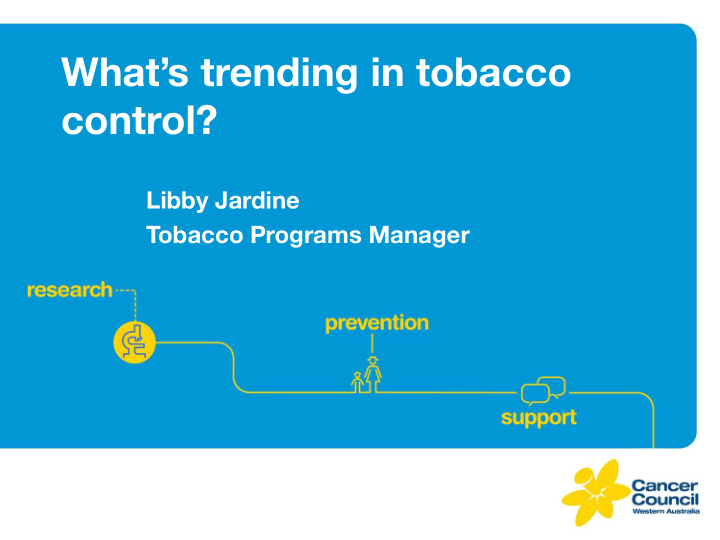



What’s trending in tobacco control? Libby Jardine Tobacco Programs Manager
Outline • Smoking trends in WA • 16 Cancers • E-cigarettes • Who still smokes? • Supporting your patients to quit 2
Smoking has never been more deadly Two thirds of deaths in current Australian smokers • attributable to smoking (much higher than international estimations of 50%) Current smokers cut at least 10 years off their lifespan • Even among less heavy smokers (those smoking an • average of 10 cigarettes a day) the risk of death was more than doubled Stopping smoking before age 45 appears to eliminate • most of the risk associated with smoking. Banks, Emily, et al. "Tobacco smoking and all-cause mortality in a large Australian cohort study: findings from a mature epidemic with current low smoking prevalence." BMC medicine 13.1 (2015): 38.
IARC levels of evidence for a link between tobacco and different cancer types Risk Factor Sufficient evidence Limited evidence of of carcinogenicity carcinogenicity Tobacco Smoking Oral cavity, pharynx, Female breast oesophagus, stomach, bowel, liver, pancreas, nasal cavity and para- nasal sinuses, larynx, lung , uterine cervix, ovary, urinary bladder, kidney, ureter, bone marrow Second-hand Smoke Lung Larynx, pharynx Smokeless Tobacco Oral cavity, oesophagus, pancreas 5
16 Cancers campaign 6
E-cigarettes/vapourisers (vaping) 7
Product placement 9
E-cigarettes • Anecdotal evidence is being used to promote the benefits of e-cigs BUT • Not enough is known about safety • Regulation requires more evidence • TGA have not approved E-cigs as a quitting aid 10
Legislation • Australia – E-cigs containing nicotine are banned throughout Australia – Nicotine is a schedule 7 poison • Western Australia – E-cigs with or without nicotine breach the Tobacco Control Products Act 2006 which prohibits any food, toy or other product looking like a cigarette to be sold or imported. 11
Who still smokes? • 36.9% of lone parents • 45% of Aboriginal people • 77% of homeless people, with street homeless reporting higher rates of 93% • 63% of vulnerable young people • 32.5% of people suffering common mental health problems such as anxiety and depression, and rates of up to 73% in men and 56% in women suffering serious psychiatric illnesses • 68% of people presenting for treatment for substance use disorders. Among mentally ill in-patients with co- existing alcohol and other drug problems smoking rates as high as 95% have been observed. • 79% of people in prison 12
Quitting Smoking & Relapse 13
The most successful method? • There is a growing evidence documenting that the majority of ex-smokers quit successfully without medication or other assistance 14
More info, Like us, Follow us • makesmokinghistory.org.au • facebook.com/MakeSmokingHistory WA • @msh_wa
Libby Jardine Tobacco Programs Manager ljardine@cancerwa.asn.au Oceania Tobacco Control Conference www.otcc2015.org.au
Recommend
More recommend